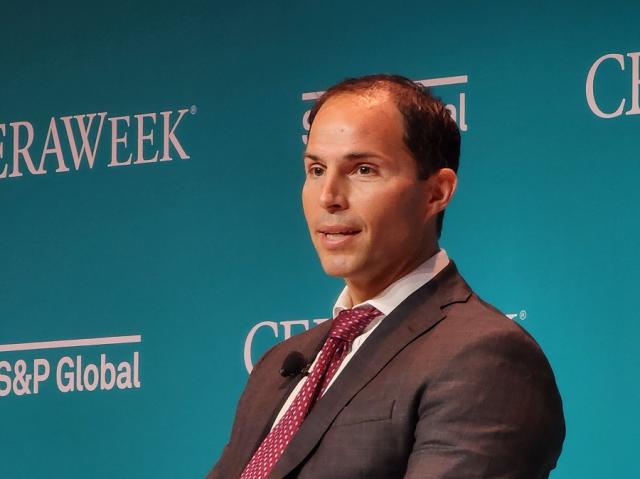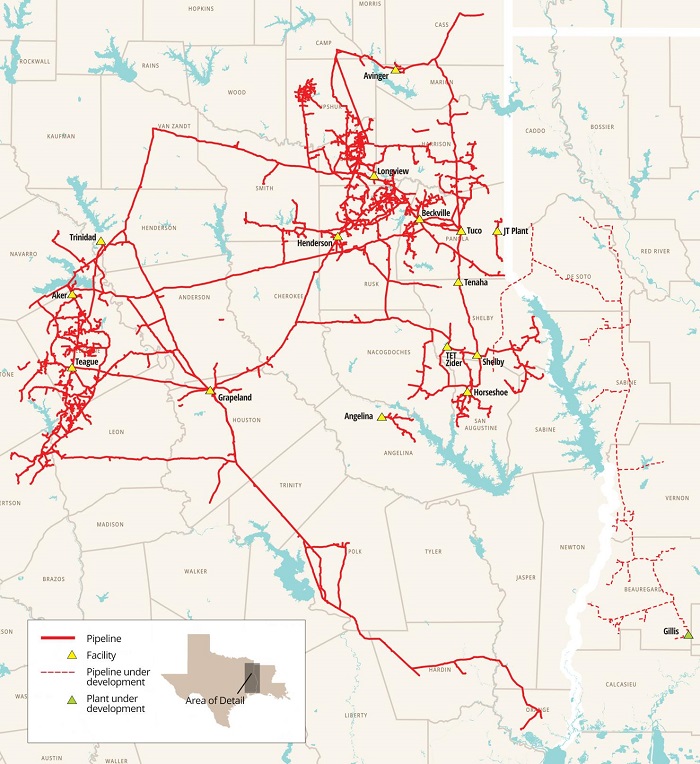
Chesapeake's COO said consistency in political messaging is what’s needed to make the mega-billion-dollar commitments to get the resource to markets. (Source: Jennifer Martinez, Hart Energy)
There are plenty more producible U.S. natural gas reserves than currently economic, according to Josh Viets, COO of Chesapeake Energy Corp.
“The thing about the U.S. natural gas industry is we don’t lack resource,” he said at CERAWeek by S&P Global. “There’s over 1,000 Tcf of resource in the ground that we know about and that we can unlock with technologies that exist today.”
Since the 19th century, the E&P business has found a way to discover more reserves and produce the resource economically, he noted.
Thus, “my guess is the number’s probably two to three times that when it’s all said and done,” Viets said.
To grow, though, the gas industry needs mega-billion-dollar investments and political administrations that don’t pose commitment risk on investments, he said.
“If there’s no certainty that those returns can be generated on investment, that doesn’t happen. So I think providing [certainty] of supply, providing access and with some consistency in messaging is going to be paramount.”
Viets referenced comments made by Ditte Juul Jørgensen, director-general for energy at the EU, who spoke in a prior sessions at CERAWeek.
“She made it very clear that natural gas is a key component of their energy infrastructure until 2050,” Viets said. “Now, she did put a [timeline] on it and that was pretty clear. But for her to say, ‘Go tell all your friends, all your industry cohorts: We need U.S. natural gas,’ we don’t always hear that [here].”
Meanwhile, LNG operators and pipeline operators need enormous capital commitments. “These are billions of dollars of investments,” he noted.
Ultimately, there needs to be political messaging that is consistent. “It’s so dangerous for us all to sit here and think, ‘Well, if I just wait until the next administration, maybe things will change.’
“Because then, a few years after that, you’re thinking, ‘I hope the administration doesn’t change because it’s going to put us right back where we were.’”
On and off switch on carbon

The White House has regularly flipped an on/off switch on carbon. U.S. oil and gas producers are moving forward on reaching net-zero goals whether the button is on or off, though.
“The whole concept of sustainability has really taken on a new lens over the last several years,” Viets said.
Towards its ‘net zero by 2035’ goal, a couple of Chesapeake projects in particular are getting the company there quickly: eliminating field emissions and carbon capture and storage.
The company has retrofitted more than 19,000 gas-driven pneumatics to date, taking its methane intensity down to 0.02%.
“To put that in perspective, if you’re familiar with the Oil & Gas Climate Initiative, which is a multinational CEO-led organization, they have a target by 2030 of 0.2%,” Viets said. “So we’re an order of magnitude ahead of that already.”
Also some 80% of Chesapeake’s production is being continuously monitored for fugitive emissions, alerting headquarters in Oklahoma City in real time.
“But we do recognize that, as an E&P operator, [we] will always have some level of carbon or methane emission. It’s just not possible with today’s technology to fully abate it,” he said.
So Chesapeake’s partnership with Momentum Midstream on the newbuild Momentum NG3—a 275-mile pipe carrying 2.2. Bcf/d to the Gulf Coast—includes extracting and sequestering the CO2 from its Haynesville Shale gas before sending it to buyers.
“That project alone will allow us to offset roughly a third of the company’s emissions once that’s placed into service.”
‘Cash flow machine’
Meanwhile, in the Marcellus, CO2 isn’t an issue, he added. “’Is the Appalachian region constrained?’ Yes, it absolutely is,” he said. “But what we love about the Marcellus specifically is that the operational breakevens are extremely low.
“There’s no CO2. There’s no H2S. It produces very little water. Honestly, it’s probably the simplest operation I’ve ever been a part of. The well returns are great, overall cost structures are low, decline rates are relatively low.”
Simply put, “it’s a cash flow machine,” he said.
That makes growing its Haynesville portfolio possible. “It’s high-decline. It’s high-cost. There’s H2S. There’s CO2. [This] ultimately pushes up breakevens.”
But the gas it makes can actually get to market, he said, particularly as LNG worldwide, since infrastructure along the Gulf Coast isn’t capacity-short.
Recommended Reading
E&P Highlights: Aug. 26, 2024
2024-08-26 - Here’s a roundup of the latest E&P headlines, with Ovintiv considering selling its Uinta assets and drilling operations beginning at the Anchois project offshore Morocco.
E&P Highlights: Sept. 16, 2024
2024-09-16 - Here’s a roundup of the latest E&P headlines, with an update on Hurricane Francine and a major contract between Saipem and QatarEnergy.
Private Equity Looks for Minerals Exit
2024-07-26 - Private equity firms have become adroit at finding the best mineral and royalties acreage; the trick is to get public markets to pay more attention.
Baytex Energy Joins Eagle Ford Shale’s Refrac Rally
2024-07-28 - Canadian operator Baytex Energy joins a growing number of E&Ps touting refrac projects in the Eagle Ford Shale.
EOG Resources Wildcatting Pearsall in Western Eagle Ford Stepout
2024-07-17 - EOG Resources spud the well June 25 in Burns Ranch with rights to the Pearsall well about 4,000 ft below the Eagle Ford, according to myriad sources.
Comments
Add new comment
This conversation is moderated according to Hart Energy community rules. Please read the rules before joining the discussion. If you’re experiencing any technical problems, please contact our customer care team.






